Besides lettering, there is a reason why our logo is a crescent moon. I believe the greatest part of this collaborative art form we call the theatre is the audience. As I see it, we artists with all our bluster and emoting, lighting and sound, props, costumes, sets, etc. are merely the moon. We are nothing but a big hunk-o-rock until an audience comes along and hits us with some light – their own insights, introspections, interpretations, revelations, etc.
But there is another side of that crescent, and it symbolizes our open circle waiting for you to come in and join us around the fire as we share our stories. Whether it is at your Girl Scout Jamboree or the camp ground gathering where you and your family sit with folks from other campsites, you trade stories and experiences from all parts of the country and the world. It’s the original internet and we are happy to have you at ours.
 Suzanne Richard has a BA in Dramatic Arts from the University of North Carolina at Chapel Hill. With Open Circle Theatre she received a Helen Hayes nomination for Outstanding Direction and Outstanding Production of a Resident Musical for Jesus Christ Superstar. She currently works as a professional actress in the DC area with such companies as The Folger, Fords Theatre, Washington Shakespeare Company, Imagination Stage, and 1st Stage. She also works as a consultant to the U.S. International Council on Disabilities, where she was previously the Outreach Coordinator, and as a Program Partner and Master Teaching Artist with Story Tapestries. At the National Endowment for the Arts, she served as the Accessibility Specialist in the Office of Accessibility. She served on the Maryland Governor’s Advisory Committee for Genetic and Heritable Disorders and the Governor’s Advisory Committee for Careers in the Arts for Persons with Disabilities. Along with frequently speaking on disability issues and genetics for the Human Genome Project, she authored the chapter “Dealing with Being Different” for Growing Up with Osteogenesis Imperfecta along with chapters in various books on arts and disabilities.
Suzanne Richard has a BA in Dramatic Arts from the University of North Carolina at Chapel Hill. With Open Circle Theatre she received a Helen Hayes nomination for Outstanding Direction and Outstanding Production of a Resident Musical for Jesus Christ Superstar. She currently works as a professional actress in the DC area with such companies as The Folger, Fords Theatre, Washington Shakespeare Company, Imagination Stage, and 1st Stage. She also works as a consultant to the U.S. International Council on Disabilities, where she was previously the Outreach Coordinator, and as a Program Partner and Master Teaching Artist with Story Tapestries. At the National Endowment for the Arts, she served as the Accessibility Specialist in the Office of Accessibility. She served on the Maryland Governor’s Advisory Committee for Genetic and Heritable Disorders and the Governor’s Advisory Committee for Careers in the Arts for Persons with Disabilities. Along with frequently speaking on disability issues and genetics for the Human Genome Project, she authored the chapter “Dealing with Being Different” for Growing Up with Osteogenesis Imperfecta along with chapters in various books on arts and disabilities.
